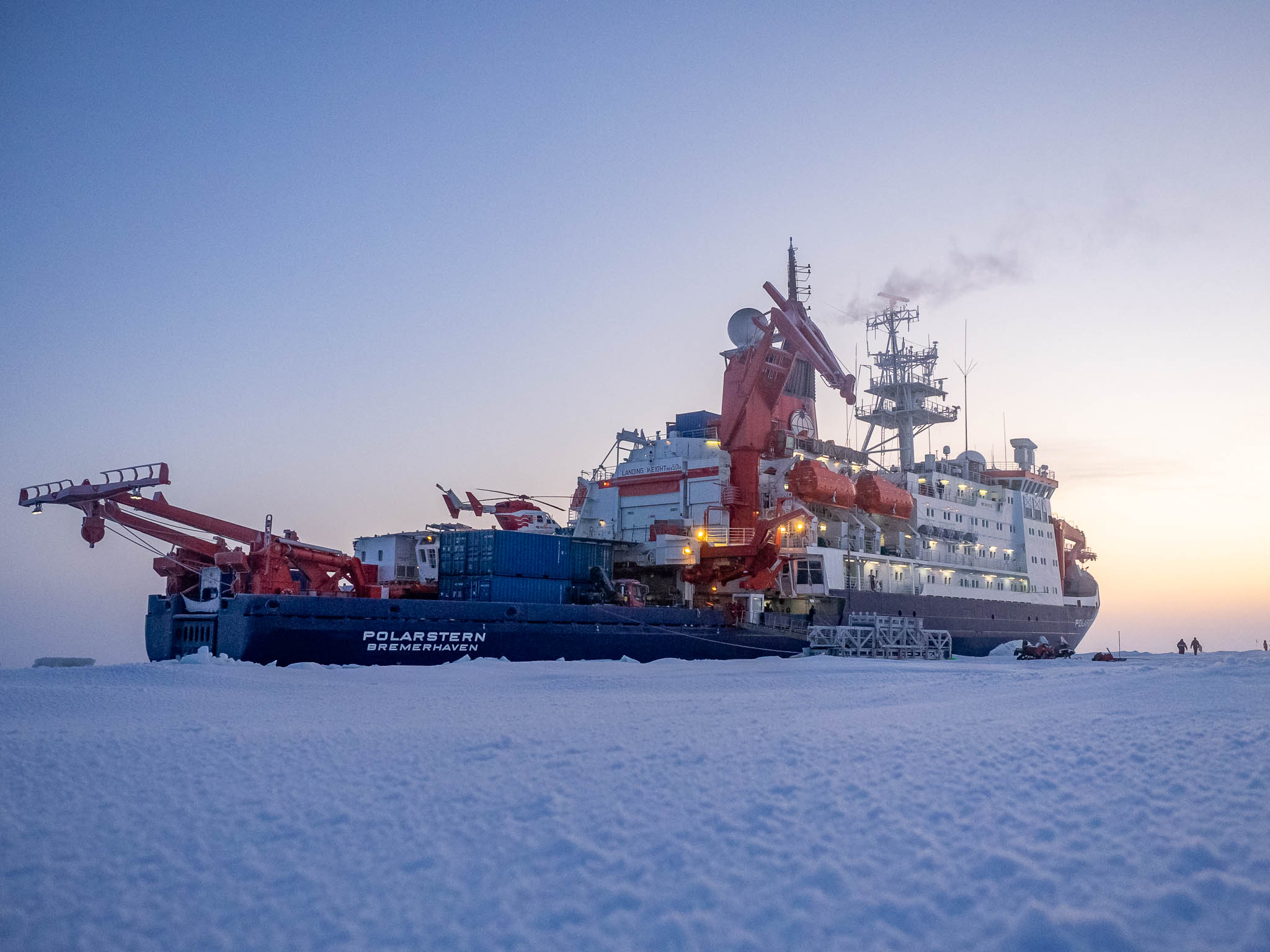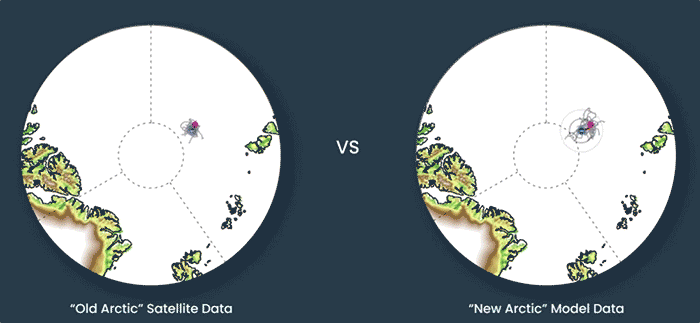Arctic research expedition likely faces extreme conditions in fast-changing Arctic
New study suggests research ship frozen into sea ice may end operations early in 'a totally different ice regime'
Apr 20, 2020 - by Ali Branscombe
Apr 20, 2020 - by Ali Branscombe

The German icebreaker, the Polarstern, frozen into Arctic sea ice. Scientists at NCAR have modeled the potential tracks the ship could take as it follows the ice floe in the 'new Arctic' conditions. (Photo courtesy of Marc Oggier, IARC, @megavolts_ak.)
In October 2019, scientists trapped a ship filled with equipment in Arctic sea ice with the intention of drifting around the Arctic Ocean for a full year, gathering data on the polar regions and sea ice floes. However, a new study indicates there is a chance the expedition may melt out months before the year-end goal.
The MOSAiC (Multidisciplinary drifting Observatory for the Study of Arctic Climate) research team went through extensive preparation and training for the expedition, including analyzing historic conditions. The new research shows, however, that Arctic conditions have been changing so rapidly that the past may no longer be a guide to today.
Scientists at the National Center for Atmospheric Research (NCAR) have used an ensemble of multiple climate model runs to simulate conditions along potential routes for the polar expedition, using today’s conditions in the “new Arctic.” The results suggest that thinner sea ice may carry the ship farther than would be expected compared to historical conditions and the sea ice around the ship may melt earlier than the 12-month goal. Of the 30 model runs analyzed in the new study, five (17%) showed melt-out in less than a year.
The research, published in the journal The Cryosphere, was funded by the National Science Foundation, which is NCAR’s sponsor. The study's co-authors are from the University of Colorado Boulder and the school's Cooperative Institute for Research in Environmental Sciences, as well as Dartmouth College and the University of Alaska Fairbanks.
The ensemble of 30 model runs used current climate conditions and reflected the breadth of ways sea ice could form, drift, and melt in a 2020 climate. The study did not incorporate 2019 ice conditions and is not a forecast of the track the ship will take over its year-long expedition.
“The whole point of MOSAiC is to understand the new Arctic and how things have changed over the last 10 years,” said Alice DuVivier, an NCAR climate scientist and lead author of the new study. “This model gives us an understanding of the range of drifting possibilities the expedition could face in the new ice regime.”
Scientists have been gathering data on Arctic sea ice extent, which can cover millions of square miles in winter, since 1979 when satellites began capturing annual changes in ice cover. “The changes in the Arctic system are so incredibly rapid that even our satellite observations from 15 years ago are unlike the Arctic today,” said Marika Holland, NCAR scientist and co-author of the study. “Now there is thinner ice, which moves more quickly, and there is less snow cover. It is a totally different ice regime.”

To compare the differences between the “old Arctic” and “new Arctic,” the scientists created ice floe tracks for the expedition’s ship, a German research icebreaker called the Polarstern, using the sea ice model in the NCAR-based Community Earth System Model (CESM). First, the scientists ran 28 model tracks based on historic satellite data of sea ice conditions. Then they compared the results to 30 model tracks under the young, thin, and more seasonal Arctic ice conditions that are more reflective of recent conditions.
In these “new Arctic” conditions, the ice floes moved more quickly so their paths extend farther and varied more from each other compared to “old Arctic” paths, which include thicker sea ice and shorter, slower tracks.
Most notably, the study finds that in the seasonal Arctic scenario, 17% of the simulated tracks show the Polarstern melting out of the ice altogether, months before the October 2020 finish line. The model runs estimate July 29, 2020, as the earliest potential melt date, highlighting that the present-day Arctic has an increased risk of extreme events, such as melt-out. In contrast, none of the tracks run under the historic satellite data showed a melt-out scenario.
While the results provide additional insight into the potential outcome of MOSAiC’s path, the model runs are not a forecast of the expedition’s track, said DuVivier, who presented the study’s results to the MOSAiC science team as they prepared for the campaign. Rather, the results are a way to explore the many scenarios a ship could potentially face over the course of the journey in the current climate. “Modeling is a way to explore many worlds,” said DuVivier. “Previous experience isn’t always indicative of what is going to happen.”
By the first phase of the expedition, in fall 2019, the researchers had already encountered thin ice conditions, having initially struggled to find a thick enough ice floe to anchor the Polarstern, and experiencing storms that have challenged the expedition. According to the National Snow & Ice Data Center, the Arctic sea ice in 2019 reached the second-lowest minimum in the satellite record, meaning the expedition began under extremely low ice conditions.
Since then, the ship’s current track has been drifting farther than expected. “The model experiments from this study have comparable tracks to what the Polarstern has been experiencing in the last few months,” said DuVivier. “We are not making a prediction for the expedition, but those types of tracks melt out early in our climate model.”
Time will tell what the Polarstern’s ultimate track and destination will be, but the expedition will still provide scientists with a wealth of data. The information will ultimately be hugely beneficial for improving climate models like CESM and helping scientists understand the changes in the Arctic that future polar expeditions may go on to observe.
“This is why we need MOSAiC. Models can inform these kinds of campaigns and these campaigns are going to inform our models,” said Holland, who has her own project on the MOSAiC expedition, collecting data about snow on sea ice and upper-ocean heating that affects sea ice thickness.
“We don’t have a lot of new observations taken in this new regime, and this will be fundamental to our future understanding of the Arctic,” said Holland.